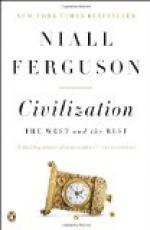|
This section contains 514 words (approx. 2 pages at 400 words per page) |

|
Conclusion, The Rivals Summary and Analysis
A great many writers across Western history have been attracted to the idea that civilizations rise and fall in a clear, cyclical pattern. Marx and Hegel tried to explain these cycles in terms of underlying factors. For Marx, it was due to economic patterns, whereas for Hegel it was due to ideas. But cyclical theories persist to this day, such as Jared Diamond's grand theory of rise and fall which bases civilizational patterns on their use of natural resources.
For Ferguson, civilizations are very complex organizations that totter between order and disorder. They can appear in long-term equilibria when in fact they're unstable and constantly adapting. Human intelligence as expressed in civilizations is a spontaneous order with emergent properties that are hard to understand.
Interestingly, the first great Western civilization, the Roman Empire, declined and fell in...
(read more from the Conclusion, The Rivals Summary)
|
This section contains 514 words (approx. 2 pages at 400 words per page) |

|




